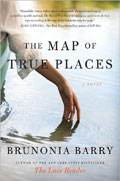Bestlseiing author Brunonia Barry discusses the creative process that's fueled her two book group favorites: The Lace Reader and The Map of True Places. Win a copy of The Map of True Places this month on ReadingGroupGuides.com by entering here.
 I wanted to write a book that was about a hero’s journey for women. I’m always amazed by what our stories do to women. Particularly movies. If you have a strong female character, they usually kill her off. Like in Terms of Endearment. And if they don’t die of some disease, they drive over a cliff like in Thelma and Louise. And if they prevail, it is usually in a very masculine way, by fighting and killing and being physically stronger than her opponent like Sigourney Weaver's character in Alien. I wanted to see what a woman’s heroic journey might look like.
I wanted to write a book that was about a hero’s journey for women. I’m always amazed by what our stories do to women. Particularly movies. If you have a strong female character, they usually kill her off. Like in Terms of Endearment. And if they don’t die of some disease, they drive over a cliff like in Thelma and Louise. And if they prevail, it is usually in a very masculine way, by fighting and killing and being physically stronger than her opponent like Sigourney Weaver's character in Alien. I wanted to see what a woman’s heroic journey might look like. I was fumbling around for a while, trying to get the project going and I was frustrated because nothing seemed to be happening, just a lot of dead ends. Then one night I had a dream about a piece of lace that my grandmother had actually given me. It was about 50 years old and was made by a nun in a Ireland. It was something that my grandmother cherished. In the dream, my grandmother handed me the piece of lace and told me that I should stare into it until I seesomething. As the dream continued, I saw the image of a horse coming toward me, which for me, is a danger sign, as I am deathly allergic to horses in real life and would quickly turn away from any horse approaching me.
When I awoke the next morning, the dream stuck with me but I had no idea what it meant --- a horse were coming toward me. There are no horses nearby, and we live in a relatively urban environment so it didn’t make any sense. Later that day, I had to meet with my contractor, as we were making renovations to our home. He was about to start demolition on an interior wall in our kitchen, and, as we talked about the project, he mentioned that “This horse hair plaster is nasty, dusty stuff. The dust gets into everything.” I immediately stopped the demolition until we could figure out how to absolutely contain all the dust. That remark probably saved me a trip a trip to the emergency room. Suddenly, I had a connection between my dream and the real world: Horses were coming toward me --- right in my own kitchen.
When I sat down to write that day, the idea of seeing things in a piece of lace stuck with me. This idea of having an ability to “read” lace intrigued me, so I began to investigate a variety of subjects, including the history of lace, the development of intuition, the town of Salem, and more. The more I read, the more questions I had about who made lace, what it meant to them, how can we improve out intuition, and so on. It also tied in nicely with my hero’s journey for women theme, as lacemakers were predominantly female and women are more in touch with their intuitive capabilities.
With these basic elements in place, I began the writing process. Now, it might sound funny to someone who hasn’t written a novel before, but the truth is that I wasn’t always sure where the story was going. I mean, in the morning, I did think that I’d write about this or that on that day. But very often, by the end of the day, I’d find that what I’d written was completely different from what I had intended to write. I found myself surprised by this phenomena, but I quickly got used to it. I felt that I had contacted my muse for the book and that the story was somehow being given to me. I was still doing the writing and the editing, but I am convinced that some of the story elements and plot turns came form somewhere outside of myself. Some of them, I didn’t even like and others I had no idea of how to incorporate into the story. I am fanatical about story structure, so when I’m given a curveball story element, it really upsets my sense of order in the storytelling.
Needless to say, when I realized that this project was going to be written in a very intuitive manner, I ultimately had to relax and trust the process. That’s not to say that I let any old idea end up on the final pages, but rather that I would carefully examine everything I would cut out and was sure to save the bits and pieces, as I felt that perhaps I just wasn’t sure where to put them yet. As it turned out, I did end up being able to use several "scrap" pieces in the book. They simply came to me too early but ended up being used a few months later.

